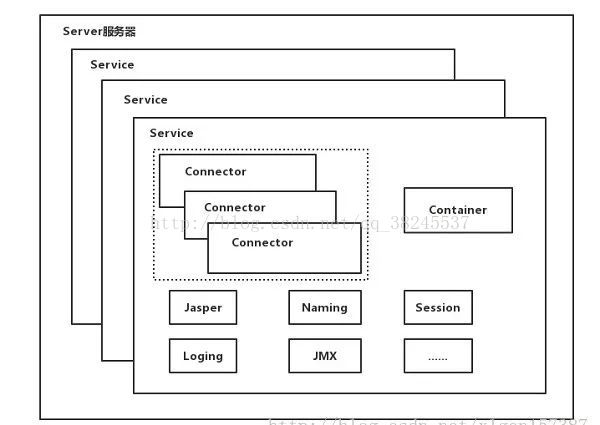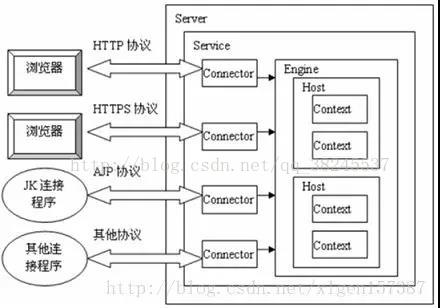SpringBoot內建tomcat啟動原理
前言
不得不說SpringBoot的開發者是在為大眾程式猿謀福利,把大家都慣成了懶漢,xml不配置了,連tomcat也懶的配置了,典型的一鍵啟動系統,那麼tomcat在springboot是怎麼啟動的呢?
內建tomcat
開發階段對我們來說使用內建的tomcat是非常夠用了,當然也可以使用jetty。
<dependency> <groupId>org.springframework.boot</groupId> <artifactId>spring-boot-starter-web</artifactId> <version>2.1.6.RELEASE</version> </dependency>
@SpringBootApplication public class MySpringbootTomcatStarter{ public static void main(String[] args) { Long time=System.currentTimeMillis(); SpringApplication.run(MySpringbootTomcatStarter.class); System.out.println("===應用啟動耗時:"+(System.currentTimeMillis()-time)+"==="); } }
這裡是main函式入口,兩句程式碼最耀眼,分別是SpringBootApplication註解和SpringApplication.run()方法。
釋出生產
釋出的時候,目前大多數的做法還是排除內建的tomcat,打瓦包(war)然後部署在生產的tomcat中,好吧,那打包的時候應該怎麼處理?
<dependency> <groupId>org.springframework.boot</groupId> <artifactId>spring-boot-starter-web</artifactId> <!-- 移除嵌入式tomcat外掛 --> <exclusions> <exclusion> <groupId>org.springframework.boot</groupId> <artifactId>spring-boot-starter-tomcat</artifactId> </exclusion> </exclusions> </dependency> <!--新增servlet-api依賴---> <dependency> <groupId>javax.servlet</groupId> <artifactId>javax.servlet-api</artifactId> <version>3.1.0</version> <scope>provided</scope> </dependency>
更新main函式,主要是繼承SpringBootServletInitializer,並重寫configure()方法。
@SpringBootApplication
public class MySpringbootTomcatStarter extends SpringBootServletInitializer {
public static void main(String[] args) {
Long time=System.currentTimeMillis();
SpringApplication.run(MySpringbootTomcatStarter.class);
System.out.println("===應用啟動耗時:"+(System.currentTimeMillis()-time)+"===");
}
@Override
protected SpringApplicationBuilder configure(SpringApplicationBuilder builder) {
return builder.sources(this.getClass());
}
}從main函式說起
public static ConfigurableApplicationContext run(Class<?> primarySource, String... args) {
return run(new Class[]{primarySource}, args);
}
--這裡run方法返回的是ConfigurableApplicationContext
public static ConfigurableApplicationContext run(Class<?>[] primarySources, String[] args) {
return (new SpringApplication(primarySources)).run(args);
}public ConfigurableApplicationContext run(String... args) {
ConfigurableApplicationContext context = null;
Collection<SpringBootExceptionReporter> exceptionReporters = new ArrayList();
this.configureHeadlessProperty();
SpringApplicationRunListeners listeners = this.getRunListeners(args);
listeners.starting();
Collection exceptionReporters;
try {
ApplicationArguments applicationArguments = new DefaultApplicationArguments(args);
ConfigurableEnvironment environment = this.prepareEnvironment(listeners, applicationArguments);
this.configureIgnoreBeanInfo(environment);
//列印banner,這裡你可以自己塗鴉一下,換成自己專案的logo
Banner printedBanner = this.printBanner(environment);
//建立應用上下文
context = this.createApplicationContext();
exceptionReporters = this.getSpringFactoriesInstances(SpringBootExceptionReporter.class, new Class[]{ConfigurableApplicationContext.class}, context);
//預處理上下文
this.prepareContext(context, environment, listeners, applicationArguments, printedBanner);
//重新整理上下文
this.refreshContext(context);
//再重新整理上下文
this.afterRefresh(context, applicationArguments);
listeners.started(context);
this.callRunners(context, applicationArguments);
} catch (Throwable var10) {
}
try {
listeners.running(context);
return context;
} catch (Throwable var9) {
}
}既然我們想知道tomcat在SpringBoot中是怎麼啟動的,那麼run方法中,重點關注建立應用上下文(createApplicationContext)和重新整理上下文(refreshContext)。
建立上下文
//建立上下文
protected ConfigurableApplicationContext createApplicationContext() {
Class<?> contextClass = this.applicationContextClass;
if (contextClass == null) {
try {
switch(this.webApplicationType) {
case SERVLET:
//建立AnnotationConfigServletWebServerApplicationContext
contextClass = Class.forName("org.springframework.boot.web.servlet.context.AnnotationConfigServletWebServerApplicationContext");
break;
case REACTIVE:
contextClass = Class.forName("org.springframework.boot.web.reactive.context.AnnotationConfigReactiveWebServerApplicationContext");
break;
default:
contextClass = Class.forName("org.springframework.context.annotation.AnnotationConfigApplicationContext");
}
} catch (ClassNotFoundException var3) {
throw new IllegalStateException("Unable create a default ApplicationContext, please specify an ApplicationContextClass", var3);
}
}
return (ConfigurableApplicationContext)BeanUtils.instantiateClass(contextClass);
}這裡會建立AnnotationConfigServletWebServerApplicationContext類。
而AnnotationConfigServletWebServerApplicationContext類繼承了ServletWebServerApplicationContext,而這個類是最終集成了AbstractApplicationContext。
重新整理上下文
//SpringApplication.java
//重新整理上下文
private void refreshContext(ConfigurableApplicationContext context) {
this.refresh(context);
if (this.registerShutdownHook) {
try {
context.registerShutdownHook();
} catch (AccessControlException var3) {
}
}
}
//這裡直接呼叫最終父類AbstractApplicationContext.refresh()方法
protected void refresh(ApplicationContext applicationContext) {
((AbstractApplicationContext)applicationContext).refresh();
}//AbstractApplicationContext.java
public void refresh() throws BeansException, IllegalStateException {
synchronized(this.startupShutdownMonitor) {
this.prepareRefresh();
ConfigurableListableBeanFactory beanFactory = this.obtainFreshBeanFactory();
this.prepareBeanFactory(beanFactory);
try {
this.postProcessBeanFactory(beanFactory);
this.invokeBeanFactoryPostProcessors(beanFactory);
this.registerBeanPostProcessors(beanFactory);
this.initMessageSource();
this.initApplicationEventMulticaster();
//呼叫各個子類的onRefresh()方法,也就說這裡要回到子類:ServletWebServerApplicationContext,呼叫該類的onRefresh()方法
this.onRefresh();
this.registerListeners();
this.finishBeanFactoryInitialization(beanFactory);
this.finishRefresh();
} catch (BeansException var9) {
this.destroyBeans();
this.cancelRefresh(var9);
throw var9;
} finally {
this.resetCommonCaches();
}
}
}//ServletWebServerApplicationContext.java
//在這個方法裡看到了熟悉的面孔,this.createWebServer,神祕的面紗就要揭開了。
protected void onRefresh() {
super.onRefresh();
try {
this.createWebServer();
} catch (Throwable var2) {
}
}
//ServletWebServerApplicationContext.java
//這裡是建立webServer,但是還沒有啟動tomcat,這裡是通過ServletWebServerFactory建立,那麼接著看下ServletWebServerFactory
private void createWebServer() {
WebServer webServer = this.webServer;
ServletContext servletContext = this.getServletContext();
if (webServer == null && servletContext == null) {
ServletWebServerFactory factory = this.getWebServerFactory();
this.webServer = factory.getWebServer(new ServletContextInitializer[]{this.getSelfInitializer()});
} else if (servletContext != null) {
try {
this.getSelfInitializer().onStartup(servletContext);
} catch (ServletException var4) {
}
}
this.initPropertySources();
}
//介面
public interface ServletWebServerFactory {
WebServer getWebServer(ServletContextInitializer... initializers);
}
//實現
AbstractServletWebServerFactory
JettyServletWebServerFactory
TomcatServletWebServerFactory
UndertowServletWebServerFactory 這裡ServletWebServerFactory介面有4個實現類

而其中我們常用的有兩個:TomcatServletWebServerFactory和JettyServletWebServerFactory。
//TomcatServletWebServerFactory.java
//這裡我們使用的tomcat,所以我們檢視TomcatServletWebServerFactory。到這裡總算是看到了tomcat的蹤跡。
@Override
public WebServer getWebServer(ServletContextInitializer... initializers) {
Tomcat tomcat = new Tomcat();
File baseDir = (this.baseDirectory != null) ? this.baseDirectory : createTempDir("tomcat");
tomcat.setBaseDir(baseDir.getAbsolutePath());
//建立Connector物件
Connector connector = new Connector(this.protocol);
tomcat.getService().addConnector(connector);
customizeConnector(connector);
tomcat.setConnector(connector);
tomcat.getHost().setAutoDeploy(false);
configureEngine(tomcat.getEngine());
for (Connector additionalConnector : this.additionalTomcatConnectors) {
tomcat.getService().addConnector(additionalConnector);
}
prepareContext(tomcat.getHost(), initializers);
return getTomcatWebServer(tomcat);
}
protected TomcatWebServer getTomcatWebServer(Tomcat tomcat) {
return new TomcatWebServer(tomcat, getPort() >= 0);
}
//Tomcat.java
//返回Engine容器,看到這裡,如果熟悉tomcat原始碼的話,對engine不會感到陌生。
public Engine getEngine() {
Service service = getServer().findServices()[0];
if (service.getContainer() != null) {
return service.getContainer();
}
Engine engine = new StandardEngine();
engine.setName( "Tomcat" );
engine.setDefaultHost(hostname);
engine.setRealm(createDefaultRealm());
service.setContainer(engine);
return engine;
}
//Engine是最高級別容器,Host是Engine的子容器,Context是Host的子容器,Wrapper是Context的子容器 getWebServer這個方法建立了Tomcat物件,並且做了兩件重要的事情:把Connector物件新增到tomcat中,configureEngine(tomcat.getEngine());
getWebServer方法返回的是TomcatWebServer。
//TomcatWebServer.java
//這裡呼叫建構函式例項化TomcatWebServer
public TomcatWebServer(Tomcat tomcat, boolean autoStart) {
Assert.notNull(tomcat, "Tomcat Server must not be null");
this.tomcat = tomcat;
this.autoStart = autoStart;
initialize();
}
private void initialize() throws WebServerException {
//在控制檯會看到這句日誌
logger.info("Tomcat initialized with port(s): " + getPortsDescription(false));
synchronized (this.monitor) {
try {
addInstanceIdToEngineName();
Context context = findContext();
context.addLifecycleListener((event) -> {
if (context.equals(event.getSource()) && Lifecycle.START_EVENT.equals(event.getType())) {
removeServiceConnectors();
}
});
//===啟動tomcat服務===
this.tomcat.start();
rethrowDeferredStartupExceptions();
try {
ContextBindings.bindClassLoader(context, context.getNamingToken(), getClass().getClassLoader());
}
catch (NamingException ex) {
}
//開啟阻塞非守護程序
startDaemonAwaitThread();
}
catch (Exception ex) {
stopSilently();
destroySilently();
throw new WebServerException("Unable to start embedded Tomcat", ex);
}
}
}//Tomcat.java
public void start() throws LifecycleException {
getServer();
server.start();
}
//這裡server.start又會回到TomcatWebServer的
public void stop() throws LifecycleException {
getServer();
server.stop();
}//TomcatWebServer.java
//啟動tomcat服務
@Override
public void start() throws WebServerException {
synchronized (this.monitor) {
if (this.started) {
return;
}
try {
addPreviouslyRemovedConnectors();
Connector connector = this.tomcat.getConnector();
if (connector != null && this.autoStart) {
performDeferredLoadOnStartup();
}
checkThatConnectorsHaveStarted();
this.started = true;
//在控制檯列印這句日誌,如果在yml設定了上下文,這裡會列印
logger.info("Tomcat started on port(s): " + getPortsDescription(true) + " with context path '"
+ getContextPath() + "'");
}
catch (ConnectorStartFailedException ex) {
stopSilently();
throw ex;
}
catch (Exception ex) {
throw new WebServerException("Unable to start embedded Tomcat server", ex);
}
finally {
Context context = findContext();
ContextBindings.unbindClassLoader(context, context.getNamingToken(), getClass().getClassLoader());
}
}
}
//關閉tomcat服務
@Override
public void stop() throws WebServerException {
synchronized (this.monitor) {
boolean wasStarted = this.started;
try {
this.started = false;
try {
stopTomcat();
this.tomcat.destroy();
}
catch (LifecycleException ex) {
}
}
catch (Exception ex) {
throw new WebServerException("Unable to stop embedded Tomcat", ex);
}
finally {
if (wasStarted) {
containerCounter.decrementAndGet();
}
}
}
}
附:tomcat頂層結構圖

tomcat最頂層容器是Server,代表著整個伺服器,一個Server包含多個Service。從上圖可以看除Service主要包括多個Connector和一個Container。Connector用來處理連線相關的事情,並提供Socket到Request和Response相關轉化。Container用於封裝和管理Servlet,以及處理具體的Request請求。那麼上文提到的Engine>Host>Context>Wrapper容器又是怎麼回事呢? 我們來看下圖:

綜上所述,一個tomcat只包含一個Server,一個Server可以包含多個Service,一個Service只有一個Container,但有多個Connector,這樣一個服務可以處理多個連線。
多個Connector和一個Container就形成了一個Service,有了Service就可以對外提供服務了,但是Service要提供服務又必須提供一個宿主環境,那就非Server莫屬了,所以整個tomcat的宣告週期都由Server控制。
總結
SpringBoot的啟動主要是通過例項化SpringApplication來啟動的,啟動過程主要做了以下幾件事情:配置屬性、獲取監聽器,釋出應用開始啟動事件初、始化輸入引數、配置環境,輸出banner、建立上下文、預處理上下文、重新整理上下文、再重新整理上下文、釋出應用已經啟動事件、釋出應用啟動完成事件。在SpringBoot中啟動tomcat的工作在重新整理上下這一步。而tomcat的啟動主要是例項化兩個元件:Connector、Container,一個tomcat例項就是一個Server,一個Server包含多個Service,也就是多個應用程式,每個Service包含多個Connector和一個Container,而一個Container下又包含多個子容器。
